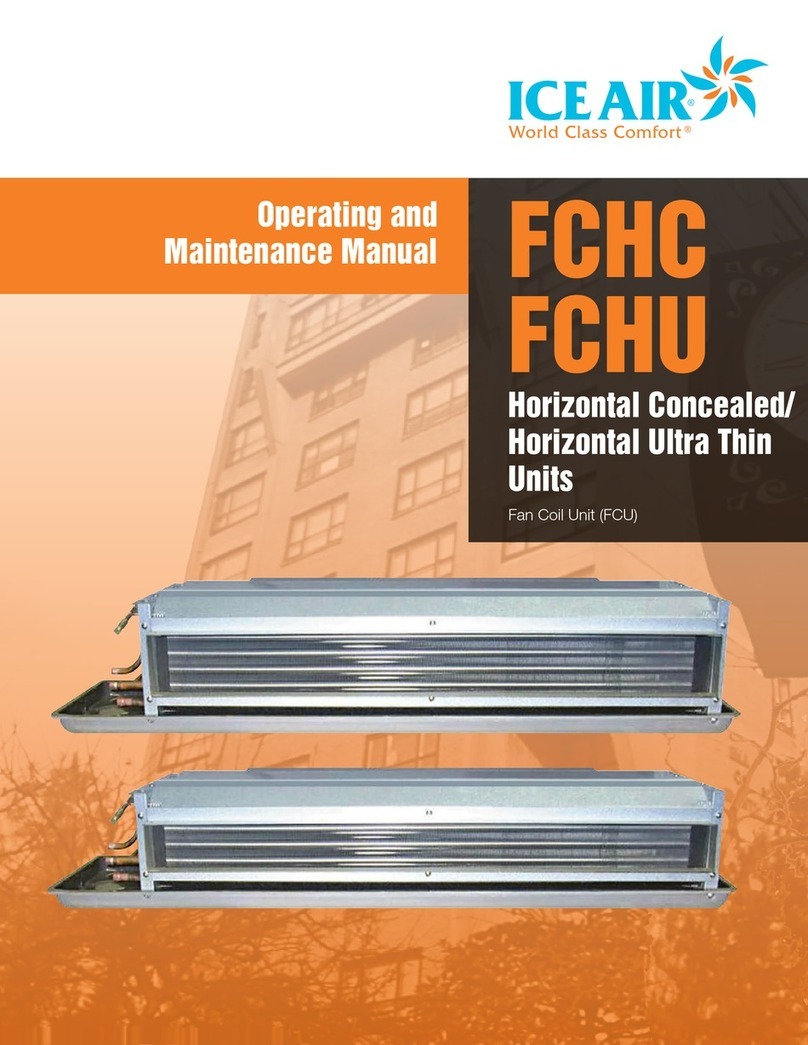
3
Precautions and preparations listed are for general knowledge and to define basic guidelines. Local codes and existing practices should be observed and preformed by a professional.
Due to Ice Air’s ongoing product development programs, the information in this document is subject to change without notice.
Consumer Reference Information
For safe and optimal enjoyment of your Ice Air unit, please read
the following consumer safety and operating notes carefully before
operating your equipment!
p
! RECOGNIZE THIS SYMBOL AS A SAFETY PRECAUTION.
p
!WARNING: Ice Air will not be responsible for any injury or
property damage arising from improper service, or service
procedures. If you install or perform service on this unit, you
assume responsibility for any personal injury or property
damage which may result. Many jurisdictions require a license
to install or service heating and air conditioning equipment.
p
!WARNING HIGH VOLTAGE: Disconnect all power before
servicing or installing unit. Multiple power sources may be
present. Failure to do so may cause property damage,
personal injury or death.
Safety Guidelines
Read this entire manual before operating the unit.
p
!WARNING: This unit MUST be serviced only by professionally
trained and qualified technicians. Do NOT attempt to maintain or
service this unit on your own – severe injury and death can occur
from electric shock, moving parts, and other hazards.
• Your Ice Air unit must be properly installed and commissioned
to operate correctly. Improper unit installation, adjustment or
commissioning, and/or improper heating system installation and
connection can lead to equipment malfunction and hazardous
operating conditions, and may void your warranty. If you have
any doubt about the proper installation of your Ice Air unit,
please contact your property manager at once to have a qualified
technician inspect the equipment.
• Your Ice Air units must each be wired on an individual, dedicated
electrical circuit with the correct voltage and proper amperage
(capacity) to match the unit nameplate requirements.
• Each unit’s electrical circuit must have a proper overcurrent
protection device, employing an approved circuit breaker or fuse
of the proper rating under NEMA and local building codes.
p
!WARNING: Every unit contains refrigerant within a sealed and
pressurized refrigerant system. This system must not be opened
or tampered with and any refrigeration system repairs MUST be
carried out by trained technicians. Refrigerant must be properly
handled and recycled per EPA regulations and guidelines.
p
!WARNING: Do NOT operate the unit with frayed, burnt or
damaged electrical wires!
p
!WARNING: Do NOT operate the equipment when in doubt –
have it inspected first!
IMPORTANT: It is not the intent of this maintenance manual to
correct any installation deficiencies. If you have any doubt about the
proper initial installation (or re-installation after servicing) of your Ice
Air unit(s) – noisy or inefficient unit operation, frayed or damaged
electrical connections, improper unit appearance, etc. – please
contact a trained servicer or building maintenance staff immediately.
The following physical conditions must be maintained for
proper unit operation:
Air flow must be unobstructed into and out of the unit return air
opening.
• Have the unit filter properly cleaned and serviced to prevent air
blockage from dirt and dust within the filter media.
Intended for indoor use only.
Proper installation and operating environment must be maintained.
Therefore:
• Do not operate the unit in corrosive environments such as
chemical plants, refineries or salt spray areas.
• Operate only with proper electrical service and protective circuit
breakers or fuses in place.
• Operate only with all unit and enclosure sheet metal parts in
place and properly installed.
• In areas of high concentrations of dirt, dust, pet dander or
pollutants, clean the filter often (at least monthly).
• Do not clean the unit with any solvents or cleaning solutions that
may damage the equipment.
• Understand and follow the unit operating instructions before
using your Ice Air equipment.






























